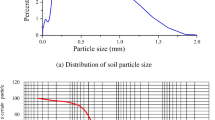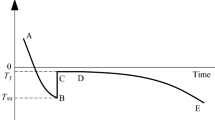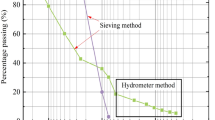Abstract
Frost heave damage is caused by the in situ freezing of pore water and segregated ice due to moisture migration. Previous studies have shown that in freezing soil, moisture migration is related to the pore water pressure gradient, and moisture migration is the dominant reason for the formation of an ice lens. However, the essential relationship between ice segregation and the matric potential is still controversial. Using a pF meter sensor, a 5TM volume water content sensor, and a digital image capture system, the relationship between the matric potential and the unfrozen water in saturated freezing soil was monitored in real time, and digital images of the formation of segregated ice were collected. Furthermore, the time space coupling relationships between the unfrozen water, the matric potential, the frost-heaving amount, the moisture migration, and the formation of an ice lens were systematically analyzed during soil freezing. The results demonstrate that there is an internal relationship between the moisture migration driven by the matric potential (from the micro-perspective) and the segregated ice layer effect (from the macroscopic perspective). In addition, the unfrozen water and the matric potential in the frozen area have a significant impact on the distribution of the segregated ice lenses.













Similar content being viewed by others
References
Akagawa S, Hiasa S, Kanie S (2008) Pore water and effective pressure in the frozen fringe during soil freezing [C]. Proceedings of the Ninth International Conference on Permafrost (Volume 1), Fairbanks: Institute of Northern Engineering, University of Alaska Fairbanks, pp 13–18
Anderson DM (1997) General aspect of the physical state of water and water movement in frozen soils[C]. Int. Symp. On Frost Action in Soils, Lilea University of Technology (2):2–16
Arenson L, Azmatch T, Sego D (2008) A new hypothesis on ice lens formation in frost-susceptible soils[C]. Proceedings of the Ninth International Conference on Permafrost (Volume 1). Fairbanks: Institute of Northern Engineering, University of Alaska Fairbanks, pp 59–64
Azmatch T, Arenson L, Sego D, et al. (2008) Measuring ice lens growth and development of soil strains during frost penetration using particle image velocimetry (GeoPIV) [C]. Proceedings of the Ninth International Conference on Permafrost (Volume 1). Fairbanks: Institute of Northern Engineering, University of Alaska Fairbanks, pp 89–94
Azmatch TF, Sego DC, Arenson LU et al (2011) Tensile strength and stress-strain behavior of Devon silt under frozen fringe conditions. Cold Reg Sci Technol 68:85–90
Chen FX, Song ZP, Li N (2006) Study on moisture migrating force model of freezing soil base on adsorption-film moisture migration mechanism. Journal of Water Resources and Architectural Engineering 4(3):1–4 (In Chinese)
Cheng G (1983) The mechanism of repeated-segregation for the formation of thick layered ground ice. Cold Reg Sci Technol 8(1):57–66
Croney D, Coleman JD, Bridge PM (1952) The suction of moisture held in the soil and other porous materials. Road Research Technical Paper, No. 24. Her Majesty’s Stationary office, London
Dortz SH, Tilston RL, Sparrman T et al (2009) Contributions of matric and osmotic potentials to the unfrozen water content of frozen soil. Geoderma 148:392–398
Everett DH (1961) The thermodynamics of frost damage to porous solids. Trans Faraday Soc 57:1541–1551
Fukuda M, Orhun A, Luthin JN (1980) Experimental studies of coupled heat and moisture transfer in soils during freezing. Cold Reg Sci Technol 3(2):223–232
Groenevelt PH, Kay BD (1974) On the interaction of water and heat transport in frozen and unfrozen soils: II. The liquid phase. Soil Sci Soc Am J 38(3):237–246
Hopke S (1980) A model for frost heave including overburden. Cold Reg Sci Technol 3(2):111–127
Ji Y, Zhou G, Zhou Y et al (2018) Frost heave in freezing soils: a quasi-static model for ice lens growth. Cold Reg Sci Technol
Kay BD, Groenevelt PH (1974) On the interaction of water and heat transport in frozen and unfrozen soils: I. Basic theory; the vapor phase. Soil Sci Soc Am J 38(3):395–400
Konrad JM, Lemieux N (2005) Influence of fines on frost heave characteristics of a well-graded base-course material. Can Geotech J 42(2):515–527
Loch J, Miller R (1975) Tests of the concept of secondary frost heaving. Soil Sci Soc Am J 39(6):1036–1041
Miller RD (1972) Freezing and heaving of saturated and unsaturated soils[C]//51st Annual Meeting of the Highway Research Board. Washington D. C.: Highway Research Record, (393):1–11
Nakano Y, Tice AR et al (1982) Transport of water in frozen soil: experimental determination of soil-water diffusivity under isothermal conditions. Adv Water Resour 5:221–226
Schofield RK (1935) The pF of water in the soil. Int Congress Soil Sci Trans 3rd (Oxford GB) 3:37–48
Suguta A, Ishizaki T, Fukuda M (1997) Characteristics of the soil structure of frozen soils. Netherlands A A Balkema, pp 165–169
Talamucci F (2003) Freezing processes in porous media: formation of ice lenses, swelling of the soil. Math Comput Model 37(5–6):595–602
Topp GC, Davis JL, Annan AP (1980) Electromagnetic determination of soil water content: measurements in coaxial transmissions lines. Water Resource Res 16(3):574–582
Topp GC, Davis JL, Annan AP (1982) Electromagnetic determination of soil water content using TDR (I). Application of wetting fronts and steep gradients. Soil Sci Soc Am J 4(6):672–678
Wang YT, Wang DY, Ma W et al (2016) Experimental study of development of cryostructure and frost heave of the Qinghai-Tibet silty clay under one-dimensional freezing. Rock Soil Mech 37(5):1333–1342 (In Chinese)
Wang D, Wang Y, Ma W et al (2017) Study on the freezing-induced soil moisture redistribution under the applied high pressure. Cold Reg Sci Technol 145
Watanabe K (2002) Relationship between rater and super cooling in the formation of ice lenses in a glass powder. J Cryst Growth 237-239:2194–2198
Wen Z, Ma W, Feng W et al (2012) Experimental study on unfrozen water content and soil matric potential of Qinghai-Tibetan silty clay. Environ Earth Sci 66(5):1467–1476
Xia D (2006) Frost heave studies using digital photographic technique [D]. University of Alerta, Edmonton, AB, Canada, MSc Thesis
Xue K, Wen Z, Zhang ML, et al. (2015) The applicability evaluation of 5TM on heat and moisture research in frozen soil. J Eng Geol 23(suppl). (In Chinese)
Xue K, Yang MB, Wen Z et al (2018) pF meter-based research on soil freezing characteristic curves. China J Highway Transp 31(3):22–29 (In Chinese)
Zhou J, Wei C, Wei H et al (2014) Experimental and theoretical characterization of frost heave and ice lenses. Cold Reg Sci Technol 104-105:76–87
Funding
This study was supported by the National Natural Science Foundation of China (Grant Nos. 41672304 and 41701063), the Scientific Research and Innovation Team Project of Sichuan Educational Committee (No. 16TD0006), and the Foundation of State Key Laboratory of Frozen Soil Engineering (No. SKLFSE201214).
Author information
Authors and Affiliations
Corresponding author
Rights and permissions
About this article
Cite this article
Xue, K., Wen, Z., Zhu, Z. et al. An experimental study of the relationship between the matric potential, unfrozen water, and segregated ice of saturated freezing soil. Bull Eng Geol Environ 80, 2535–2544 (2021). https://doi.org/10.1007/s10064-020-02052-x
Received:
Accepted:
Published:
Issue Date:
DOI: https://doi.org/10.1007/s10064-020-02052-x




